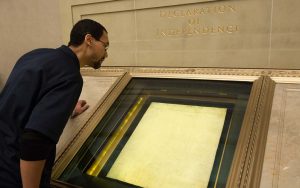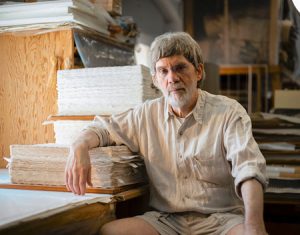America’s founding documents sit on an Iowa-made foundation
July 4th, 2025 by Ric Hanson
(Radio Iowa) – Our nation’s three most important and revered documents are enclosed in titanium display cases in the rotunda of the National Archives in Washington, D.C., and they rest on custom-made archival paper created at the University of Iowa. Tim Barrett, the now-retired director of the U-I Center for the Book, says he got the call in 1999 to create the special paper to cradle the Constitution, the Bill of Rights and the Declaration of Independence. Was that his dream job?
“I and my coworkers were all more immediately focused on, ‘Okay, they want us to go ahead and do this. Now, we actually have to do it and we can’t mess up. This is kind of a big deal,'” Barrett says, laughing. “Rather than letting it go to our heads, we really focused on making the paper and getting it to the National Archives.” The center on the Iowa City campus had developed a sterling reputation for being able to create special types of handmade paper from pure American-grown, textile-quality cotton using a custom-built press.
There was just one problem: “Most of the paper we made was smaller than what they needed. They needed 36-by-36-inch sheets and we didn’t have a press to squeeze out the water from the damp sheets,” Barrett says, “so we had to construct a larger press and build other pieces of equipment to be ready to go into production.” It took a few months to assemble and perfect using everything, and then it was just a matter of minutes to create the paper, which took another day to press and dry. In all, they shipped a few dozen sheets of the additive-free paper to the National Archives, and it should be good for many decades to come.

Photo from the National Archives
The highly-fortified cases were designed with aluminum plates as a base for the precious documents, which were written some two-and-a-half centuries ago on vellum, a parchment made from animal skin. “They wanted the paper in there to provide a lighter background to help illuminate, to help show off the parchment documents, to provide a cushion against the perforated aluminum plate,” Barrett says, “and also to provide a relative humidity buffer within the encasement.” The U-I Center for the Book is dedicated to preserving arts that date back centuries, like bookbinding, letterpress printing, and making paper by hand.
Barrett says it was a tremendous honor to be chosen for this project by the National Archives, which hosts more than a million visitors every year.”I’ve been there several times and it’s well worth a visit because the lighting is subdued and there’s an atmosphere of real reverence,” Barrett says. “You can wait your turn in line and walk up there and get your face literally within inches of these very important pieces of American history.” He says all residents of the state, when they go to see the Declaration of Independence and the other documents, should feel a sense of gratification.

Tim Barrett (UI photo)
“The most important thing for me, and I think for any Iowan who goes to the National Archives Rotunda, once you get in there and you get up close to those documents, if you move your head off to the side a little bit, underneath them all, you can see this white piece of paper and you know, that was made in the state of Iowa,” Barrett says, “and that’s something to be really proud of.” And by the way, the masterminded theft of the Declaration of Independence depicted in the 2004 film “National Treasure” starring Nicolas Cage? Barrett says rest assured, it’ll never happen.
https://uicb.uiowa.edu/


